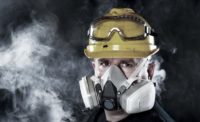History
The U.S. Department of Labor became aware of the dangers of respirable crystalline silica in the 1930s, but it wasn’t until 1971 that silica exposure standards were set by the newly-established OSHA. The final rule issued on March 25, 2016 is comprised of two standards, one for Construction and one for General Industry and Maritime.
Why this standard is important
An estimated 2.3 million workers are exposed to respirable crystalline silica in their workplaces, primarily in construction, general industry and hydraulic fracturing. Exposure can occur during the drilling, cutting, crushing, or grinding of silica-containing materials such as concrete and stone and during brick manufacturing and foundry operations.
Hazards
When inhaled, the very small respirable particles in silica dust can penetrate deep into the lungs and cause disabling and sometimes fatal lung diseases such as silicosis and lung cancer, as well as kidney disease.
Enforcement Statistics
Because the rule was issued this year, there are no enforcement statistics available yet.
Key Provisions
- Reduces the permissible exposure limit (PEL) for respirable crystalline silica to 50 micrograms per cubic meter of air, averaged over an 8-hour shift.
- Requires employers to use engineering controls to limit worker exposure; provide respirators when engineering controls cannot adequately limit exposure; limit worker access to high exposure areas; offer medical exams to highly exposed workers, and train workers on silica risks and how to limit exposures.
Industries that may be cited
Crystalline silica exposure can occur in following industries and operations:
- Construction
- Glass products
- Structural clay products
- Concrete products
- Foundries
- Paintings and coatings
- Refractory products
- Cut stone and stone products
- Hydraulic fracturing for gas and oil
- Maritime work
What must employers do to protect employees?
- Where possible, silica should be eliminated or substituted with a safer option.
- Engineering controls should then be considered, such as using local exhaust ventilation, using containment methods (e.g., blast-cleaning machines and cabinets), and wet sawing or wet drilling of silica-containing materials.
- Administrative or work practice controls may include limiting workers’ exposure time and requiring workers to shower and change into clean clothes before leaving a worksite.
- Personal protection equipment such as proper respiratory protection may be used to keep workers' exposure below the OSHA PEL.
Respirable Crystalline Silica Compliance Directive:
Directive number: CPL 03-00-007
Compliance date: January 24, 2008
Subject: National Emphasis Program - Crystalline Silica
Compliance Assistance:
Crystalline Silica Exposure in General Industry. This OSHA Health Hazard Information Card provides good work practices for workers.
A Guide to Working Safely With Silica: If It's Silica, It's Not Just Dust. This NIOSH guide provides information about the health hazards of silica and suggests ways to prevent silicosis.




